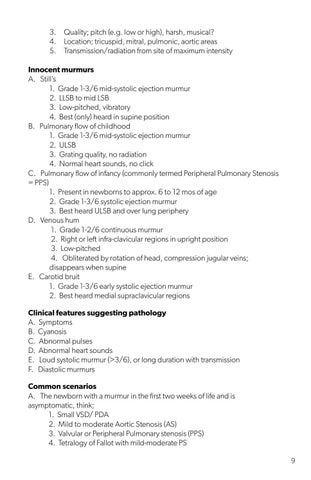3. 4. 5.
Quality; pitch (e.g. low or high), harsh, musical? Location; tricuspid, mitral, pulmonic, aortic areas Transmission/radiation from site of maximum intensity
Innocent murmurs A. Still’s 1. Grade 1-3/6 mid-systolic ejection murmur 2. LLSB to mid LSB 3. Low-pitched, vibratory 4. Best (only) heard in supine position B. Pulmonary flow of childhood 1. Grade 1-3/6 mid-systolic ejection murmur 2. ULSB 3. Grating quality, no radiation 4. Normal heart sounds, no click C. Pulmonary flow of infancy (commonly termed Peripheral Pulmonary Stenosis = PPS) 1. Present in newborns to approx. 6 to 12 mos of age 2. Grade 1-3/6 systolic ejection murmur 3. Best heard ULSB and over lung periphery D. Venous hum 1. Grade 1-2/6 continuous murmur 2. Right or left infra-clavicular regions in upright position 3. Low-pitched 4. Obliterated by rotation of head, compression jugular veins; disappears when supine E. Carotid bruit 1. Grade 1-3/6 early systolic ejection murmur 2. Best heard medial supraclavicular regions Clinical features suggesting pathology A. Symptoms B. Cyanosis C. Abnormal pulses D. Abnormal heart sounds E. Loud systolic murmur (>3/6), or long duration with transmission F. Diastolic murmurs Common scenarios A. The newborn with a murmur in the first two weeks of life and is asymptomatic, think; 1. Small VSD/ PDA 2. Mild to moderate Aortic Stenosis (AS) 3. Valvular or Peripheral Pulmonary stenosis (PPS) 4. Tetralogy of Fallot with mild-moderate PS 9


